| San Diego State University |
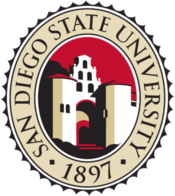 |
| 校训 |
Minds that move the world |
| 建立于 |
1897 |
| 类型 |
Public
Space Grant |
| 捐赠 |
$115.1 million (2008) |
| 校长 |
Stephen L. Weber |
| 工作人员 |
1,684 |
| 学生 |
29,256 (fall 2009) |
| 本科生 |
24,134 |
| 研究生 |
5,122 |
| 位置 |
San Diego, California, United States |
| 校园 |
Urban |
| 曾用名 |
San Diego Normal School (1897-1923)
San Diego Teachers College (1923-35)
San Diego State College (1935-70) |
| Carnegie status |
Research University with high research activity |
| 颜色 |
black and scarlet (red) |
| 昵称 |
Aztecs |
| Mascot |
Aztec warrior |
| 体育运动 |
17 varsity teams |
| 归属 |
California State University system
Mountain West Conference (NCAA Division 1) |
| 网址 |
sdsu.edu |
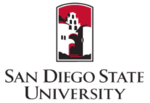 |

|
For a railway station that serves the campus, see SDSU Transit Center.
San Diego State University (SDSU), founded in 1897 as San Diego Normal School, is the largest and oldest higher education facility in the greater San Diego area (generally the City and County of San Diego), and is part of the California State University system. It is the third-oldest university in the California State University system, and one of the oldest universities in California. SDSU has a student body of approximately 29,256 (as of the beginning of the Fall 2009 academic year) and an alumni base of more than 200,000. San Diego State University had an acceptance rate of 31.2 % for the 2008 academic year. According to SDSU's website, the university received 62,000 applications for the 2008 school year.
The Carnegie Foundation has designated San Diego State University a "Research University with high research activity." SDSU is the only California State University campus with this classification, which places it among the top 200 higher education institutions in the country conducting research. Notably, pursuant to the Faculty Scholarly Productivity Index (FSP Index) released by the Academic Analytics organization of Stony Brook, NY, SDSU is the number one small research university in the United States as of the last two academic years, for both 2005-2006 and 2006-2007.. The Daily Beast in 2010, ranked SDSU No.21 in its list of "Tech's 29 Most Powerful Colleges"
San Diego State University awards bachelor's, master's, and doctoral degrees (Ph.D., Ed.D, and Au.D) in a total of 151 fields. SDSU offers the most doctoral degrees of any campus of the California State University system, currently in sixteen academic and research disciplines.
San Diego State University is a member of the American Association of State Colleges and Universities (AASCU), the National Association of State Universities and Land-Grant Colleges, the Southwest Border Security Consortium, and the Oak Ridge Associated Universities, a national organization of universities that promotes science and technology education and research.
历史
Main article: History of San Diego State University
建立于 on March 13, 1897 San Diego State University first began as the San Diego Normal School, intended to educate local future female elementary school teachers. Curriculum in a normal school was limited to what would "normally" be taught in schools. In 1923, the San Diego Normal School became San Diego State Teachers College, "a four-year public institution controlled by the state Board of Education." In 1935 the school became San Diego State College. In 1960, San Diego State College became a part of the California College System, now known as the California State University system. Finally in 1970 San Diego State College became San Diego State University (SDSU).
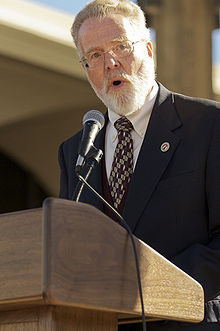
Current president Stephen Weber
One in seven San Diegans with a college degree attended SDSU, making SDSU a primary educator of the region's work force. Committed to serving the diverse San Diego region, SDSU ranks among the top ten universities nationwide in terms of ethnic and racial diversity among its student body, as well as the number of bachelor's degrees conferred upon minority students.
San Diego State University has achieved the prestigious "Research University" status granted by the Carnegie Foundation. University faculty consistently attract hundreds of millions of U.S. dollars annually in grants and contracts for research and program administration, and SDSU's research and graduate degree programs lead all other campuses of the California State University system.
For the beginning of the 2006-2007 academic year, SDSU expanded its classrooms and support space by more than 200,000 square feet (19,000 m) with the opening of three new buildings, the College of Arts and Letters, the Calpulli Center and BioScience Center. The buildings, respectively, feature high-technology classrooms, upgraded health and wellness facilities, and scientific research laboratories.
SDSU's Astronomy Department owns the Mount Laguna Observatory located in the Cleveland National Forest. It operates the observatory concurrently with the University of Illinois at Urbana-Champaign.
John F. Kennedy, then the President of the United States of America, gave the graduation commencement address at San Diego State University on June 6, 1963.
Significant rankings and distinctions
- See SDSU Significant Rankings and Distinctions
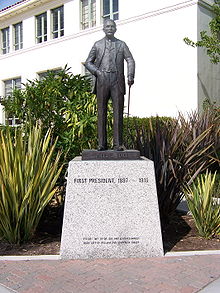
Statue of Samuel T. Black, the first president of the university
- For two years in a row, SDSU has been ranked the No. 1 most productive research university, among schools with 14 or fewer Ph.D. programs based on the Faculty Scholarly Productivity Index. --Academic Analytics, 2007
- SDSU has been designated a "Research University" with high research activity by the Carnegie Foundation.
- Since 2000, SDSU faculty and staff have attracted more than $1 billion in grants and contracts for research and program administration.
- SDSU is the largest university in San Diego and the fifth largest in California.
- In its May 2009 issue, Playboy magazine ranked SDSU the third best party school in the nation (behind only the University of Miami and University of Texas at Austin).
- One in seven adults in San Diego who holds a college degree attended SDSU.
- SDSU is home to the first-ever MBA program in Global Entrepreneurship. As part of the program, students study at four universities worldwide, including the United States, China, the Middle East, and India. Corporate partners include Qualcomm, Invitrogen, Intel, Microsoft, and KPMG.
- In 1970, SDSU founded the first women's studies program in the country.
Schools and colleges
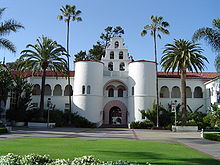
A landmark architecture (Hepner Hall) featured in the school's logo
- College of Arts & Letters
- College of Business Administration
- College of Education
- College of Engineering
- College of Health & Human Services (and Graduate School of Public Health)
- College of Sciences
- College of Professional Studies & Fine Arts
- College of Extended Studies (and American Language Institute)
知名校友与教职
Main article: List of San Diego State University alumni and faculty
[edit] Endowment
- See also San Diego State University Research Foundation for additional information
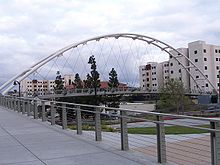
Pedestrian bridge connecting various residence halls and parking structures to campus
The permanent financial endowment of San Diego State University (SDSU) is currently valued at $120.3 million U.S. dollars (USD) as of the end of the 2007 academic year.
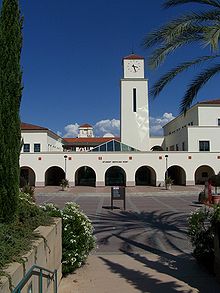
Student Services building with clock tower
The primary philanthropic arm of San Diego State University is The Campanile Foundation, controlled by the University Advancement division of the university. The San Diego State University Research Foundation, an auxiliary corporation owned and controlled by the university, is the manager and administrator of all philanthropic funds and external funding for the university and its affiliated and auxiliary foundations and corporations.
As of June 30, 2006, permanent assets of the SDSU Campanile Foundation totaled $134 million.
For the 2004-2005 academic year, SDSU received over $157 million USD in external funding from grants and contracts, as well as an additional $57 million USD in donations and charitable giving. For 2005-2006, SDSU received $152 million USD in grants and contracts to support research. This is followed by $47.7 million USD in donations, gifts and other charitable giving.
An auxiliary to The Campanile Foundation is the Aztec Athletic Association, which primarily raises funds for the student athletes in the San Diego State University athletics programs (see discussion of Athletics below and at SDSU Aztecs).
In addition to its permanent endowment, San Diego State University raises over $55 million U.S. dollars per year (approximately) in philanthropic gifts to support its research and academic affairs.
Budget Shortfall
The California State University system budget is being cut by $564 million this year, with SDSU's budget being reduced by $55 million. As a result of California’s state budget cuts, student enrollment is being reduced by 4, 618 by Fall 2010.
Academic and research affairs
San Diego State University is the leader in the California State University system in awarding Ph.D. (joint with UCSD ) or Ed.D degrees, currently awarding such degrees in 16 academic disciplines. As a result of recent statutory changes (SB 724), SDSU intends to expand the scope and number of doctoral degree programs that it offers its graduate students. . SDSU has been referred to as the research flagship campus of the California State University system.
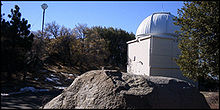
Looking at SDSU's 40-inch (1,000 mm) telescope at Mount Laguna Observatory
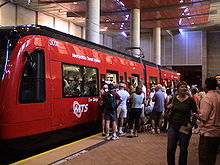
The underground San Diego Trolley station on the SDSU campus
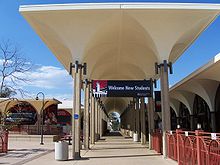
Entrance to Aztec Center, which leads into the heart of the SDSU campus
- Library
- Malcolm A. Love Library - the SDSU campus library
- Observatory
- Mount Laguna Observatory
- An astronomical observatory owned by SDSU and operating concurrently with the University of Illinois at Urbana-Champaign.
- SDSU is the only institution in the California State University system that offers a complete academic program in Astronomy, including the awarding of graduate degrees.
- Research institutes and centers
- American Language Institute (Link to American Language Institute homepage)
- International Consortium of Advanced Technologies and Security (ICATS) (Link to ICATS)
- California Institute for Transportation Safety (CITS)
- Center for Bio/Pharmaceutical and Biodevice Development at SDSU
- Center for Earth Systems Analysis Research (CESAR)
- Center for Research in Mathematics and Science Education
- Center for Interdisciplinary Studies of Youth and Space (ISYS)
- Center for International Business Education & Research
- The Center for Commercialization of Advanced Technology
- CMI Coastal and Marine Institute
- Computational Science Research Center
- Entrepreneurial Management Center - (Homepage)
- The Fred J. Hansen Institute for World Peace
- Interwork Institute
- International Security and Conflict Resolution Program (ISCOR)
- Institute for Public Health
- June Burnett Institute
- Pacific Estuarine Research Laboratory (PERL)
- The Pre-College Institute (PCI) - (Homepage)
- Regional Science Laboratory (REGAL)
- Richard C. Wright Spatial Analysis Laboratory (SAL)
- Sycuan Institute on Tribal Gaming (SITG)
- The SDSU Global Change Research Group
Demographics of student body
|
Undergraduate |
| African American |
4.0% |
| Asian American |
15.7% |
| White American |
45.3% |
| Hispanic American |
21.8% |
| Native American |
0.7% |
| International |
2.0% |
| Ethnicity unreported/unknown |
10.5% |
- Research consortium
- California Institute for Telecommunications and Information Technology (Calit2)
- Official Calit2 Site
- Calit2 Membership Page
- California Space Grant Consortium
- Official Site
- Membership Page
- Southern California Earthquake Center
- Southwest Border Security Consortium
- Southwest Consortium for Environmental Research & Policy (SCERP)
- Renowned Facilities
- Chemical Sciences Laboratory
- Coastal Waters Laboratory
- Facility for Applied Manufacturing Enterprise
- SDSU Biological Field Stations
- Tijuana River National Estuarine Research Reserve
- SDSU BioScience Center
- SDSU Michrochemical Core Facility
- Social Science Research Laboratory (SSRL)
- The Stephen and Mary Birch Foundation Center for Earth Systems Analysis Research (CESAR)
- SDSU Center for Information Technology and Infrastructure (CITI)
- The SDSU Visualization Center
- High-speed computing
- The SDSU campus is a backbone node of the High Performance Research and Education Network (HPWREN).
- Gateway of Geospatial Information Technology at SDSU
- SDSU hosts and manages the data network for San Diego County, California (NOTE: no access; password protected)
- Southern California wildfires
SDSU's high-speed computing facilities and Department of Geography are host to MAP.SDSU.EDU, a web-based mapping, wiki, and geographic information database concering the October 2007 California wildfires and the October 2003 California wildfires, managed by the San Diego GIS force group, a volunteer group of SDSU faculty and students.
- MAP.SDSU.EDU webpage
- Wild Fire Alert San Diego, a project of SDSU's Biological Field Station Program
- FireNet webpage hosted by SDSU
Media, newspapers, and magazines
- SDSU media and publications
- San Diego State University Press
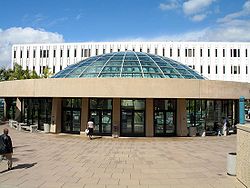
Malcolm A. Love Library and the InfoDome
-
- The oldest university press in the California State University system with noted specializations in Border Studies, Critical Theory, Latin American Studies, and Cultural Studies.
- Hyperbole Books
- KPBS Public Broadcasting TV/FM
- Television, digital television, and FM radio for the San Diego community
- Official site of KPBS
- An affiliate of the Public Broadcasting Service (PBS) network
- "A Broadcasting Service of San Diego State University"
- KCR (AM)
- Student-run broadcast station
- 360 Magazine
- The quarterly SDSU alumni and San Diego community magazine
- Official SDSU campus newspapers
- The SDSU News & Media webpage
- SDSUniverse news service
- News and information for the SDSU community
- The Daily Aztec - The largest daily collegiate newspaper in California, publishing daily since 1960.
SDSU Transit Center
- SDSU Transit Center (San Diego Trolley station)
Extracurriculars
体育运动
Main article: San Diego State Aztecs
The first major sport on campus was rowing, but it initially had no coaches or tournaments. Other sports that developed early in the campus's history were tennis, basketball, golf, croquet, and baseball. The school's football program had such a limited selection of players that faculty had to be used to fill the roster. When the college merged with the junior college in 1921, SDSU became a member of the Junior College Conference. After the school won the majority of the conference titles in a variety of sports, the league requested that SDSU leave out of fairness to the smaller schools. For its football program, the team outscored its opponents 249 to 52 in ten games, resulting in the first sales of season tickets in 1923. From 1925-26, SDSU played as an independent. It then joined the Southern California Conference in 1926, where it did not win a football conference championship until 1936. However, in other sports including tennis and basketball, it excelled. SDSU remained with the conference until 1939, when it joined the California Collegiate Athletic Association.
The basketball team reached and won multiple championships games during the 1930-40s, including a conference title in 1931, 1934, 1937, and 1939. It reached the national championship in 1939 and 1940, losing in the final rounds. However, in 1941 SDSU returned and won the college's first national title. In track, the team won conference titles in 1935, 1936, 1937, 1938, and 1939. The football team won conference titles in 1936 and 1937, and the baseball team won three conference titles and placed second three times between 1935-1941.
In 1955, the Aztec Club was established and raised $20,000 a year by 1957. The club worked in increasing athletic scholarships, hiring better coaches, and developing the college’s intercollegiate athletic programs. In 1956, students approved through a vote of allowing a mandatory student activity fee, with a portion going to athletics. By the end of the decade the budget had doubled to $40,000. The campus’s most successful sports program during the 1950s was cross-country as the team won eight straight conference titles, AAU regional titles, and placed high in national competitions. Basketball ranged from last in the conference to multiple conference, regional, and national appearances. The football program had its first undefeated team in 1951, but in the last part of the decade earned the worst records in the school’s football program under the direction of head coach Paul Governali.
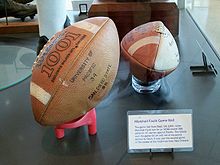
Marshall Faulk's game ball from the September 14, 1991 game when he ran for a NCAA-record 386 yards and scored 44 points
Under Governali, the campus’s football program suffered, due to Governali’s policy of not recruiting new players. To improve the program, Love hired Don Coryell in 1961, which helped the program to win three consecutive championships (1966–68), and end with a record of 104 wins, 19 losses, and 2 ties by the time he left SDSU. Coryell was assisted by John Madden, Joe Gibbs, and Rod Dowhower, among others. In Coryell’s first year, attendance at home games averaged 8,000 people, but by 1966 it had doubled to 16,000. This later jumped to 26,000-41,000 per game with the addition of the new San Diego stadium. At some games, attendance was larger than at San Diego Chargers games. There were several undefeated seasons and multiple players broke records for most catches, touchdowns, and passing yards, among others. In 1969, SDSU moved into NCAA Division 1, leaving the California Collegiate Athletic Association. In 1972, Coyrell left to pursue coaching in the NFL.
Basketball also did well, with the 1967-68 team being ranked the number one college-level team in the nation, although it did not win a national title. The Aztecs also won the 1960 CCAA baseball title, and won multiple national championships throughout the 1960s in track, cross country, and swimming.
By 1970-71, the campus had 14 NCAA sports. The 1973 men’s volleyball team won the NCAA national championship which was the first NCAA national title since moving to Division I status.
SDSU competes in NCAA Division I FBS. Its primary conference is the Mountain West Conference; its women's water polo team participates in the Mountain Pacific Sports Federation and its men's soccer team participates as an Associate Member of the Pacific-10 Conference (the "Pac-10" Conference). The ice hockey team competes in the ACHA with other western region club teams (www.sdsuhockey.com). The crew team's championship regatta is in the WIRA (Western International Rowing Association). The university colors are scarlet (red) and black, SDSU's athletic teams are nicknamed "Aztecs", and its current mascot is the Aztec Warrior, historically referred to as "Monty - Montezuma". Athletics revenues have been down recently.
- Football
- The football team plays at Qualcomm Stadium (formerly known as "Jack Murphy" Stadium). See also The Q
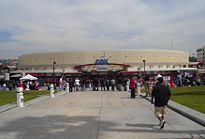
Viejas Arena (formerly Cox Arena) is used for the Aztec basketball games, speeches, convocations, and concerts
- Basketball
- The basketball teams play at Viejas Arena (see also Viejas Arena website) on the SDSU campus.
- Baseball
- The baseball team plays in Tony Gwynn Stadium on the SDSU campus, named after the SDSU baseball and basketball player and current head coach, Tony Gwynn.
- Volleyball
- The women's volleyball team plays in Peterson Gym on the SDSU campus.
- The men's volleyball team won the NCAA Championship in 1973, but the team has since been disbanded.
- Soccer
- Both the men's and women's teams both play at the Sports Deck on the SDSU campus. The women compete in the Mountain West Conference while the men compete in the Pacific-10 Conference (Pac-10).
- Ice Hockey
- Participates in the ACHA Men's Division 2.
- Advanced to National Championship final game in 2008 for ACHA Men's Division 3 and lost 7-3 to California University of Pennsylvania.
- San Diego State University Ice Hockey
- Other sports
- The new $12 million dollar aquatic sports complex (known as the Aztec Aquaplex), includes an Olympic-size swimming pool, a separate recreational pool and beach, and a hydrotherapy spa. This facility is home for the swimming and diving teams, in addition to providing recreational use for all SDSU students and community members.
- SDSU Campus Recreation pool web page
- In conjunction with the UCSD, the Associated 学生 organization of San Diego State University runs the Mission Bay Aquatic Center (MBAC) in Mission Bay, California, just a few miles west of the main campus. See also the MBAC homepage. The MBAC provides for all manner of outdoor activities and sports for SDSU students, administration, and faculty.
[edit] Clubs
- See student organizations
Initial clubs that were first started on campus including the Debating Club, the Associated Student Body, YWCA, and in 1906, an alumni association. The oldest club on campus was The Rowing Association.
Student body and Greek life
- For more information, go to SDSU Center for Fraternity and Sorority Life
The first fraternity on campus was the Delta chapter of Epsilon Eta, which formed on October 25, 1921. By the end of the decade there were six other fraternities and eight sororities. The fraternities and sororities were all local, and did not attain national status until after World War II. In 1925, in order to encourage higher grades, the Inter-Fraternity Council and Inter-Sorority Council published the average grades of the fraternity and sorority members. On a 3.0 scale, the average GPA (grade point average) for all students was 1.49, for fraternities was 1.35, and sororities was 1.47.
By the mid-1930s there were eight fraternities and eleven sororities, and later expanded to fifteen fraternities and twelve sororities in the 1940s. The first fraternity to go national was Theta Chi and the first sorority was Alpha Xi Delta. In 1962 state attorney general Stanley Mosk and president Love required the fraternities and sororities to either delete the discriminatory clauses in their constitutions or risk receiving recognition from the campus. At first all but four of the sororities refused to sign, but by 1968, the first minority student was admitted into the fraternity Sigma Pi.
On April 27, 1974 Phi Beta Kappa honor society established a SDSU chapter. It was the first in the CSU system as well as the San Diego area. During the 1960s and early 1970s, the Greek population had dwindled to 699, but gradually began to increase in the 1980s, reaching 2,900 in 1988. There were 20 fraternities and 13 sororities officially affiliated with the Inter Fraternity Council and Panhellenic Council as well as six independent fraternities/sororities. This made it one of the largest fraternity and sorority systems in the western U.S. On April 6, 1978, Gamma Phi Beta sorority hired a plane to drop marshmallows on fraternity houses during Derby Week, but the plane crashed near Peterson Gym, injuring four students aboard. In 1983 a USA Today article reported that SDSU Greeks GPAs were below the campus average, so SDSU tightened restrictions and supervision and by 1989 their grades had increased to slightly above University average. Between 1989-91, several riots among the fraternities occurred, including one numbering 3,500 people, and another requiring 34 police officers to end it. The 2008 drug bust resulted in the suspension of several fraternities as well as the arrests of multiple fraternity members. Currently there are over 48 social fraternities and sororities, including both general and culturally based organizations, represented by four governing councils.
- Fraternities (IFC)
- Alpha Epsilon Pi
- Delta Upsilon
- Kappa Sigma
- Phi Delta Theta
- Phi Kappa Psi
- Phi Kappa Theta
- Sigma Alpha Epsilon
- Sigma Chi
- Sigma Nu
- Sigma Phi Epsilon
- Zeta Beta Tau
- Alpha Beta Epsilon
- 拉丁语o fraternities (USFC)
- Nu Alpha Kappa
- Gamma Zeta Alpha
- Phi Iota Alpha
- Sigma Lambda Beta
- Sororities (Panhellenic)
- Alpha Chi Omega
- Alpha Epsilon Phi
- Alpha Phi
- Delta Gamma
- Delta Zeta
- Gamma Phi Beta
- Kappa Alpha Theta
- Kappa Delta
- Pi Beta Phi
- Sororities (Honorary)
- Tau Beta Sigma
- Sigma Tau Delta
- Psi Chi
- National Pan-Hellenic Council, Inc.
- Alpha Kappa Alpha Sorority, Inc.
- Alpha Phi Alpha Fraternity, Inc.
- Delta Sigma Theta Sorority, Inc.
- Zeta Phi Beta Sorority, Inc.
- Kappa Alpha Psi Fraternity, Inc.
- Sigma Gamma Rho Sorority, Inc.
- Phi Beta Sigma Fraternity, Inc.
- Omega Psi Phi Fraternity, Inc.
Business Fraternity
- Alpha Kappa Psi Co-ed Professional Business Fraternity, Inc.
List and map of fraternities and sororities at SDSU [2]
Traditions
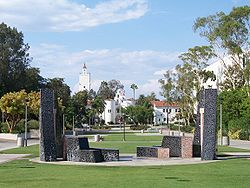
Courtyard looking towards Hepner Hall
- The San Diego State Marching Aztecs and Pep and Varsity Bands are often seen at many sporting events including Football, Basketball and even Volleyball (The University Bands).
- The San Diego State University (SDSU) campus is known as "Montezuma Mesa", as the university is situated on a mesa overlooking Mission Valley and is located at the intersection of Montezuma Road and College Avenue.
- Undie Run through campus that takes place during finals week each semester.
S mountain
"S" mountain was created by the Council of Twelve and initially supported by President Hardy. On February 27, 1931, he allowed 500 students to paint rocks, forming a 400-foot "S" on Cowles Mountain. The giant S was lit at night for the opening football game of a season (performed by the freshman to build school spirit) along with pep rallies, and was repainted throughout its history. At the time, it was the largest collegiate symbol in the world. During World War II, the S was camouflaged to prevent it becoming a reference point for enemy bombing aircraft. It was returned to its normal state in April 1944. In the 1970s students stopped painting it and brush obstructed the symbol. After a 1988 brush fire it was exposed, and students repainted it. In fall, 1997, a group of 100 volunteers climbed Cowles Mountain after dusk to commemorate the 100-year anniversary of the school by using flashlights to once again outline the "S" on the side of the mountain. In 1990, a high school prank defaced the S to read as "91" in honor of their graduating class.
School colors and mascot
The initial colors of the school were white and gold. When the junior college was added to the campus in 1921, its colors of blue and gold were merged together, resulting in a blue, gold, and white color scheme. New colors were later chosen as gold and purple, until being replaced by crimson and black on January 28, 1928.
The school's prior nicknames for its mascot included "Normalites", "Professors", and "Wampus Cats". However, after a 1924 committee met to address the issue, the name "Aztecs" was decided on. In 2003, the Aztec Warrior was approved by a student and alumni vote to become the official university mascot after the school's prior mascot, Monty Montezuma, was discontinued.
Publications
Students began publishing The White and Gold in 1902, which was a literary magazine and newspaper. In 1913, a new newspaper was established entitled Normal News Weekly. The school newspaper Paper Lantern (Normal News Weekly was renamed after the addition of the junior college) became The Aztec in September 1925. It was later expanded to its current name, The Daily Aztec. The school's annual yearbook was named Del Sudoeste (Spanish for "of the southwest") in the early 1920s.
Notable events and popular culture
- Film and television
- The two main characters from the 77th Academy Awards (2004) Academy Award-winning and Golden Globe Award-winning comedy/drama film Sideways were roommates during their college days at SDSU.
- The SDSU campus is the setting of Hearst College, the fictional university in The CW television network show Veronica Mars.(link)
- The exterior shots of Rancho Carne High School in the movie Bring it On were mainly filmed at San Diego State University
- Portions of The Real World: San Diego were filmed around the SDSU campus
- A few former Laguna Beach: The Real Orange County cast members currently attend SDSU.
- SDSU is mentioned by Bart Simpson in The Simpsons episode "The President Wore Pearls (Season 15, 2003)". Lisa becomes president of Springfield Elementary and unknowingly strips the school of all of its recreational activities, leading Bart to say, "Lisa, you made this school even worse. And it wasn't exactly San Diego State to begin with."
- 1996 campus shooting
Main article: San Diego State University shooting
The San Diego State University shooting occurred on August 15, 1996. A thirty-six year old graduate engineering student, while apparently defending his thesis, shot and killed his three professors, Constantinos Lyrintzis, Cheng Liang, and D. Preston Lowrey III, at San Diego State University. The shooter, who was suffering from certain mental problems, was convicted on July 19, 1997 and was sentenced to life in prison. As a memorial, tables with a plaque with information about each victim have been placed adjacent to the College of Engineering building.
- 2008 student drug arrests
Main article: Operation Sudden Fall
On May 6, 2008, the Drug Enforcement Administration announced the arrest of 96 individuals, of which 33 were San Diego State University students, on a variety of drug charges in a narcotics sting operation dubbed Operation Sudden Fall. It was originally reported that 75 of the arrested were students, but the inflated number included students who had been arrested months earlier, in some cases for simple possession. The bust, which was the largest in the history of San Diego County, drew a mixed reaction from the community. In addition, Associated Students President, James Poet was arrested on October 17, 2008 for driving under the influence and possession of marijuana. Poet expressed full support for the actions of Operation Sudden Fall and the Zero Tolerance Policy.
Buildings
| San Diego State College |
| U.S. National Register of Historic Places |
| U.S. Historic District |
|
|
| Location: |
5300 Campanile Dr., San Diego, California |
| Coordinates: |
32°46′33″N 117°4′16″W / 32.77583°N 117.07111°W / 32.77583; -117.07111Coordinates: 32°46′33″N 117°4′16″W / 32.77583°N 117.07111°W / 32.77583; -117.07111 |
| Architect: |
multiple |
| Architectural style(s): |
Mission/Spanish Revival |
| Governing body: |
State |
| Added to NRHP: |
September 04, 1997 |
| NRHP Reference#: |
97000924 |
Several buildings are listed on the National Register of Historic Places:
- Scripps Cottage was finished in September 1931, funded with a donation of $6,000 from Ellen Browning Scripps matched with $5,000 from the state. It was the headquarters for the Associated Women Students and was used for meetings, women's activities, and served as a lounge. On September 3, 1968 the building was moved to make room for the new library. It was used mainly as a conference and meeting building, and in 1993, began serving as a center for international students.
- Aztec Bowl, costing $500,000, the stadium was dedicated on October 3, 1936 before 7,500 people, after being completed earlier that year. The stadium was initially supposed to be expanded to 45,000 seats, but instead was only expanded once with 5,000 seats in 1948. Aztec Bowl was the only state college stadium in California at the time of its construction.
- Open Air Theatre contained 4,280 seats and was financed by the Works Progress Administration and the state for $200,000. It was dedicated in 1941.
- On January 19, 1976, the Montezuma Mesa building was renamed to Walter R. Hepner Hall, and on May 1, 1977 the humanities building was named after John Adams, a teacher, administrator, and archivist. The Humanities-Social Sciences building was renamed in 1986 after geographer Alvena Storm and historian Abraham P. Nasatir.
- In the 1980s the Open Air Theatre added new support facilities and fencing. Peterson Gym was finished in 1961, making the original gym the Women’s Gym until it was remodeled and reopened in 1990 as the Physical Education building. In 1990, 14,000 sq ft (1,300 m) were added to Storm and Nasatir Halls. In 1986, a large student apartment complex was added along with a 11-story $13,000,000 residence hall (west side of campus).
- Hardy Memorial Tower, in the Mission Revival style, resembles a Mediterranean church tower and is one of the most recognizable buildings on campus. It also performed a utilitarian function: The tower concealed a 5000 gallon water tank that provided pressure for the campus plumbing system. The building housed the university's first library, which featured murals painted by the Works Progress Administration.
- The Communications Building, Exercise & Nutritional Sciences, Faculty Staff Club, Life Science Building and Annex, Little Theatre, Physical Plant Boiler Shop, and the Physical Science Building are also listed on the National Register.
Other buildings on campus include:
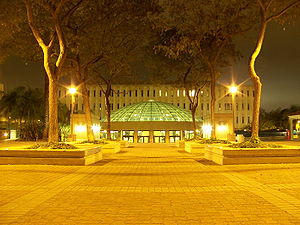
The front entrance to Love Library
- The campus library, now known as the Malcolm A. Love Library, acquired its 100,000th book on May 21, 1944. By the end of World War II it was adding about 8,000 books a year. In 1959, a 40,000 sq ft (3,700 m). addition to the library was finished, but it was already deemed too small. In 1952, the library had 125,000 books, and state regulations required that old books be eliminated before new ones could be added. By 1965, there were more than 300,000 books housed in a library that could hold 230,000. This was ranked highest in state colleges in terms of library size. In the 1960s, construction of a new library began, which required the relocation of Scripps Cottage. The $8,000,000 building was designed with 300,000 sq ft (28,000 m). of space to accommodate one million books. In February 1971, the library opened, housing 700,000 books, and was named after President Malcolm A. Love for his popularity on campus and his role in bringing State to university status. Governor Ronald Reagan said the library would "...serve as a lasting memorial to the man who led the college through its growing pains...to one of the finest state colleges in California." The building was five stories high and was the largest building on campus. A four-story sculpture entitled "Hanging Discus" by sculptor George Baker was specifically designed for the library and added to an interior staircase in November 1973.
- Construction of a $11 million alumni center began in May 2008. The center is expected to be opened in in fall 2009 and house the SDSU Alumni Association, the Campanile Foundation, as well as the university relations and development staff.
Residence Halls
In 1937, Quetzal Hall, the first dormitory, opened for 40 women students and was located off campus. In 1952, 50 college youth conducted a panty raid at Quetzal Hall, causing $1,000 in damages. Police arrested 13 of the students and the dorm girls later retaliated by attacking the Pi Kappa Alpha fraternity house. In 1968, the coed dorm Zura Hall was built, and more rooms were added later. Chapultepec Hall held 580 students when first built.
- Residence Halls
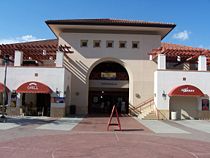
Entrance building to Cuicacalli Suites with the Aztec Grill and Aztec Market in the front
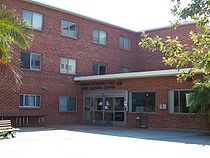
The Olmeca Living Learning Center residence hall
- West Side
- Chapultepec Hall, or "Chappy", 11 stories, houses 550 students
- University Towers, "UT", 9 stories, 550 students
- formerly known as "El Conquistador" or "El Conq"
East Side
- Cuicacalli Suites, "Cuic", houses 686 students
- Tepeyac, 6 stories
- Tacuba, 6 stories
- The Living Learning Center, "LLC", houses 426 students
- Maya, 3 stories
- Olmeca, 3 stories
- Tenochca Hall, "Tenoch", 8 stories, houses 380 students
- Zura Hall, "The Zoo", 3 tower, 9 stories, houses 585 students
- Apartments
- Aztec Corner, "AC", formerly College Manor, furnished, houses up to 600 students.
- Piedra del Sol, Unfurnished, 66-Units, houses up to 225 students
This is NOT a residence hall but university owned student housing - it has leases rather than license agreements and no RA's
- Villa Alvarado, "VA", Furnished Apartments, 90-Units, houses 360 students
- Former residence halls
Opened in 1937 as the first residence hall. It was next to present day Aztec Center.
- Templo del Sol, Zapotec, Toltec & Tarastec Halls
This complex was on the west side of the campus next to Tony Gwynn Stadium across from Chapultepec. Currently it is the site of a new Softball stadium and tennis court complex. They were the same red brick design and floor plan as Maya and Olmeca halls on the east side of campus.
Branch campuses
- Imperial Valley Campus
- Located in Calexico, California
- Additional campus in Brawley, California along with research park and related facilities
- Upper division, teacher certification, and graduate classes only
- North County Campus
- Formerly located in northern San Diego County
- Closed; converted to California State University, San Marcos
- South Bay Campus
- Formerly located on the first floor of the parking structure across from the Holiday Inn in National City, California.
- Shared facilities with Southwestern College.
- Closed indefinitely.
更多
 |
San Diego portal |
 |
University portal |
- Google Book Search San Diego State University
参考文献
- ^ "2008 NACUBO Endowment Study" (PDF). National Association of College and University Business Officers. http://www.nacubo.org/documents/research/NES2008PublicTable-AllInstitutionsByFY08MarketValue.pdf. Retrieved January 27, 2009.
- ^ Carnegie Foundation: San Diego State University
- ^ Study Ranks California's Most Productive Universities (May 31, 2007)
- ^ SDSU named most productive small research school (North County Times) (June 1, 2007)
- ^ SDSU Receives Top Research Distinction for Second Straight Year (SDSUniverse.com) (Nov. 26, 2007)
- ^ The Daily Beast[1]
- ^ SDSU Significant Rankings and Distinctions
- ^ Foundation (http://www.carnegiefoundation.org) database entry and article on San Diego State University
- ^ Mount Laguna Observatory
- ^ Forty Years Later, the Magic of JFK Lingers on the Mesa, Coleen L. Geraghty, SDSUniverse (May 12, 2003)
- ^ SDSU Library, Aztec Bowl: History of San Diego State University (accessed Jan. 16, 2009)
- ^ "Top Party Schools 2009," Playboy magazine, May 2009.
- ^ "Raising the fundraising bar" San Diego Union Tribune, February 12, 2008
- ^ The Campanile Foundation: Financial Statements June 30, 2006
- ^ 2004-2005 Annual Report on External Funding, California State University
- ^ 2005-2006 Annual Report on External Support to the CSU -- San Diego State University
- ^ "San Diego State University Reports $55.2 Million in Philanthropic Gifts for 2004-05" Official SDSU Press Release, Oct. 7, 2005"
- ^ Ruggero, Lorena. "Aztecs Rally Against Budget Cuts". 10/09/09 <http://www.palomar.edu/dsps/actc/mla/mlainternet.html>.
- ^ Weber, Stephen. "SDSU Admissions Changes". San Diego State University. 10/21/09 <http://advancement.sdsu.edu/budgetcentral/index.html>.
- ^ San Diego State University's Academic Programs
- ^ Starr, p. 28
- ^ Starr, p. 60
- ^ Starr, p. 102 & 105
- ^ Starr, p. 144-45
- ^ Starr, p. 159-62
- ^ Starr, p. 221
- ^ Schrotenboer, Brent (February 22, 2008), "Football shy of dollar goal at SDSU", San Diego Union-Tribune, http://www.signonsandiego.com/uniontrib/20080222/news_1s22azbudget.html, retrieved 2008-02-25
- ^ Starr, p. 27
- ^ Starr, p. 59
- ^ Starr, p. 96
- ^ Starr, p. 127
- ^ Fikes, Jr., Robert (2004). The Black in Crimson and Black: A History and Profiles of African Americans at SDSU. San Diego: San Diego State University. pp. 23.
- ^ Starr, p. 193
- ^ Starr, p. 214
- ^ Starr, p. 215
- ^ Starr, p. 216
- ^ McDonald, Jeff; Sherry Saavedra and Tanya Sierra (2008-05-07). "Major SDSU drug probe nets 96 arrests in raids". San Diego Union Tribune. http://www.signonsandiego.com/news/metro/20080507-9999-1n7drugs.html. Retrieved 2008-11-04.
- ^ Starr, p. 126
- ^ Starr, p. 78
- ^ Starr, p. 79
- ^ Starr, p. 112
- ^ Starr, p. 121
- ^ Starr, p. 213
- ^ Starr, p. 50
- ^ Starr, p. 53
- ^ Jenkins, Brandon; Melissa Berlant (2003-12-15). "San Diego State U.: San Diego State U. approves university mascot". The America's Intelligence Wire. http://www.accessmylibrary.com/coms2/summary_0286-19718715_ITM. Retrieved 2008-11-10.
- ^ Starr, p. 39
- ^ "Mug Shots from Operation Sudden Fall" (PDF). CBS News 8. http://www.cbs8.com/misc/SDSU_mug_shots.pdf. Retrieved 2008-05-06.
- ^ "Officials differ on number of SDSU students snared in sting". San Diego Union Tribune. http://www.signonsandiego.com/news/metro/20080508-1041-bn08arrests.html. Retrieved 2008-05-08.
- ^ "SDSU drug sting draws scorn, praise". San Diego Union Tribune. http://www.signonsandiego.com/news/metro/20080508-9999-1n8sdsu.html. Retrieved 2008-05-08.
- ^ "Poet arrested for alleged DUI and marijuana possession". The Daily Aztec. http://www.thedailyaztec.com/city/poet_arrested_for_alleged_dui_and_marijuana_possession. Retrieved 2008-10-25.
- ^ "National Register Information System". National Register of Historic Places. National Park Service. 2009-03-13. http://www.nr.nps.gov/.
- ^ "Historic Buildings of San Diego State University". Infodome - SDSU Historic Buildings. San Diego State University. http://dometest.sdsu.edu/projects/buildings/bldgs.html. Retrieved 2009-07-30.
- ^ Starr, p. 156
- ^ Starr, p. 94
- ^ Starr, p. 191
- ^ Starr, p. 202
- ^ "Hardy Memorial Tower". Infodome - SDSU Historic Buildings. San Diego State University. http://dometest.sdsu.edu/projects/buildings/hardy.html. Retrieved 2009-07-30.
- ^ Starr, p. 125
- ^ Starr, p. 138
- ^ Starr, p. 155-56
- ^ Starr, p. 187
- ^ Starr, p. 188
- ^ Starr, p. 189
- ^ Lee, Jaimy (2008-04-14). "Tucker Sadler has designs on $11m center at SDSU". San Diego Business Journal. http://www.accessmylibrary.com/coms2/summary_0286-34442995_ITM. Retrieved 2008-10-11.
- ^ Starr, p. 143
- ^ Starr, p. 168
- ^ Starr, p. 220
- ^ http://www.sa.sdsu.edu/housing/zura.html retrieved 8 December 2008
-
- See also, 2004-2005 Annual Report on External Funding, California State University
- See also, 2003-2004 Annual Report on External Funding, California State University
External links
 |
Wikimedia Commons has media related to: San Diego State University |
- San Diego State University Official 网址
- "SDSUniverse" Campus Information 网址
- SDSU Alumni Association
- Official CSUMentor information about San Diego State University CSUMentor SDSU webpage
- Official SDSU athletics site
- The Daily Aztec student newspaper
- SDSU Month The yearly SDSU-sponsored event celebrating San Diego State University and its role in the community.
- Unofficial information sources:
- NBCSandiego.com Campus Connection
- Official Maps:
- Map, Location, and Directions
- Official campus map (large GIF link)
- External reviews and information sources:
- SDSU Review – US News, “SDSU at Glance”
- SDSU's College of Business – Business Week Review
S
D
S
U |
|
College of Arts & Letters • College of Business Administration • College of Education • College of Engineering • College of Health & Human Services (and Graduate School of Public Health) • College of Sciences • College of Professional Studies & Fine Arts • College of Extended Studies • American Language Institute • Imperial Valley Campus
|
Colleges |
| List of San Diego State University alumni and faculty |
People |
|
Malcolm A. Love Library • Aztec Center • Hardy Memorial Tower • Hepner Hall • Montezuma Hall • Open Air Theater
SDSU Transit Center (San Diego Trolley station) • College Area
|
Campus |
|
SDSU Research Foundation • Biological Field Stations • HPWREN • Mount Laguna Observatory
|
Research |
|
KPBS Television • KPBS Radio • San Diego State University Press
|
Media |
|
SDSU Aztecs (football, basketball, soccer) • Qualcomm Stadium • Viejas Arena • Aztec Aquaplex • Peterson Gym • Tony Gwynn Stadium
|
Athletics |
|
The Daily Aztec • KCR Radio
|
Student Life |
|
History of San Diego State University
|
History |
San Diego State University San Diego, California
v • d • e
|
|
|



